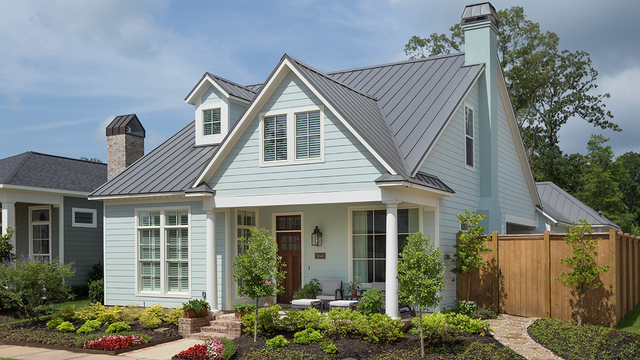
Homeowners have inflation on the brain right now as they plan for spring and summer home improvement projects. However, experts say it’s not only the sticker shock of initial project costs that consumers should be concerned about.
To make inflation-savvy decisions, homeowners need to consider how to make their improvement dollars work harder and lower their total cost of ownership over time. For major home improvement projects like re-roofing, that means factoring in not only the initial cost of materials and installation but identifying opportunities to reduce or eliminate ongoing costs and even recoup a return on the investment over time.
The Metal Roofing Alliance (MRA) suggests five ways to help inflation-proof a re-roofing project, including:
Be your own powerhouse: Add a rooftop solar system
Yes, adding a rooftop solar system when you install a new roof increases initial upfront costs, but overall, it’s more affordable than ever these days to invest in one. According to the California Energy Commission, consumers may save an estimated $80 on monthly heating, cooling and lighting bills, a positive long-term return on the investment that helps offset the higher cost.
Keep in mind that metal roofs are the best option for photovoltaic systems, greatly reducing the risk of a roof failing before a solar panel system does. The estimated lifespan of solar panels is typically about 20 to 25 years while metal roofs last for 50-plus years. That means the roof will easily outlast the panels, helping protect savings that can quickly be wiped out if the roof underneath the solar system fails prematurely.
Guard against ongoing maintenance costs
Roofing materials like asphalt, shake and clay tile can be susceptible to moss, fungus and hard-to-remove staining caused by organic materials, especially in wet or humid climates. They often require professional, regular cleaning which can add up to big expenses over time. Comparatively, cleaning a metal roof is often a DIY project and as simple as using a squirt of plain water and a dash of gentle soap to effectively wash away dirt, dust and other debris.
Up the insulation and efficiency
Choosing high performance materials, coatings and installation methods when replacing a roof adds up to real dollars and cents: Research indicates that homeowners can save up to 40 percent on annual energy costs by simply selecting the right type of roof and paying attention to proper installation practices. Many cool metal roofs are ENERGY STAR-qualified based on total solar reflectance and thermal emittance properties, a term that describes how much of a material’s absorbed energy is released and emitted back into the atmosphere (versus causing indoor temperatures to rise). The Environmental Protection Agency estimates an ENERGY STAR labeled roof can lower roof temperatures by as much as 100 degrees F.
Check building codes in your area to make sure your insulation meets or exceeds standards and work with your installer to incorporate proper eve and ridge ventilation to save on energy costs all year long.
Look for installation savings
To save on re-roofing labor costs, experts say the fact is an old intact asphalt roof doesn’t necessarily have to be torn off and removed to install a new roof. Thanks to its lighter weight, metal is one of the only roofing materials that can be installed directly over asphalt. The benefits of doing so not only include preventing waste but realizing savings that comes from reduced labor and tear-off costs while increasing long-term energy efficiency. Also, keep in mind that heavier materials like clay tile and slate can require additional structural supports, upping material and labor costs significantly.
Plan for the long run
Having to replace or repair a roof earlier than planned is an outrageously expensive and wasteful proposition. Quality metal roofs are estimated to last nearly two to three times longer than other material, can hold up to extreme weather like tornado force winds, hail and snow, and are designed to last 50-plus years, saving homeowners thousands of dollars over time.
“Metal roofs are engineered to withstand the elements in every region,” said Ken Gieseke of McElroy Metal Roofing and MRA board member. “The peace of mind that comes with knowing your home is better prepared for hurricanes, tornados, hailstorms, heavy snow and ice and wildfires is priceless.”